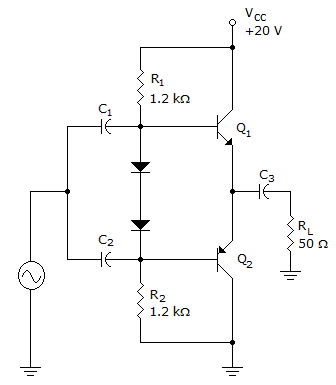Electronic Devices - Power Amplifiers
Exercise : Power Amplifiers - General Questions
- Power Amplifiers - General Questions
- Power Amplifiers - Filling the Blanks
- Power Amplifiers - True or False
51.
A class A amplifier with RC = 3.3 k and RE = 1.2 k
and RE = 1.2 k has a VCC = 20 V. Find IC(sat).
has a VCC = 20 V. Find IC(sat).
 and RE = 1.2 k
and RE = 1.2 k has a VCC = 20 V. Find IC(sat).
has a VCC = 20 V. Find IC(sat).52.
Which of the following is (are) the disadvantage(s) of a class B complementary-symmetry circuit?
53.
Which of the power amplifiers has the lowest overall efficiency?
54.
Calculate the efficiency of a class B amplifier for a supply voltage of VCC = 20 V with peak output voltage of VL(p) = 18 V. Assume RL = 16
.

55.
You find that this amplifier only shows the negative alternation at the output. The possible trouble might be that


Quick links
Quantitative Aptitude
Verbal (English)
Reasoning
Programming
Interview
Placement Papers